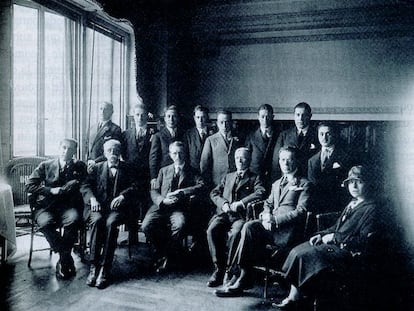The story of the only woman in the photo: María del Carmen Martínez Sancho, Spain's first female doctor of mathematics.


In an old photograph from 1928, the Board of Directors of the Spanish Mathematical Society (now the Royal Spanish Mathematical Society) poses solemnly. All in suits, all men. All except one woman on the far right: María del Carmen Martínez Sancho . Carmen, as she liked to be called, is not there out of courtesy, nor as a concession to modernity. She is the first female doctor of mathematics in Spain, an expert in the geometry of the theory of relativity.
Martínez Sancho was born on July 8, 1901, in Toledo. 26 years later, in 1927, she became the first female doctor of mathematics in Spain, with a thesis in the field of mathematical physics. She developed it at the Universidad Central (now the Complutense University) under the supervision of José María Plans, known as the mathematician who introduced the theory of relativity in Spain. In her thesis, Carmen explored the so-called Bianchi normal spaces , geometric spaces that help rigor Einstein's ideas about the universe.
These spaces were defined by the Italian mathematicianLuigi Bianchi to formalize the notion of a space-time that can expand at different rates in the three spatial dimensions. Martínez Sancho's work during his thesis focused on extending these types of spaces to contexts with more spatial dimensions than the known three: four, five, and even any natural number.
The previous year, before defending her thesis, Martínez Sancho became a member of the Board of the Spanish Mathematical Society. Shortly after, in 1928, she obtained a chair in mathematics at the Ferrol Institute, also becoming the first woman to hold such a position.
Furthermore, during the five years of his undergraduate studies, he taught at the Instituto-Escuela , a pedagogical project ahead of its time. There, he not only taught mathematics, but also learned German in teacher training courses and occasionally attended lectures—likely the one Einstein gave during his visit to Spain in 1923 .
She also obtained one of the scholarships offered by the Junta de Ampliación de Estudios (JAE) to researchers to pursue their training abroad, becoming the first in mathematics—and the fifth in all sciences—thanks to which she spent a stay at the University of Berlin. For 18 months, she attended classes with renowned geometers and analysts such as Issai Schur, Adolf Hammerstein, and Heinz Hopf. In Germany, she continued to pursue her interest in teaching, enrolling in courses on education and pedagogical psychology.
Upon her return, she was offered a position at the newly created Seville Institute-School, where she remained until her retirement, putting her research career on hold. This was the case for many young researchers at that time. While the new ideas of the early 20th century brought broad financial support to universities, they could not offer stability to their staff, and many PhDs opted for permanent positions at an institute and abandoned their research careers. Carmen, moreover, had always wanted to be a professor.
As a teacher, Martínez Sancho trained students and fostered vocations. And her short research career made her a pioneer and a leading figure. Almost a hundred years after that photograph of the Spanish Mathematical Society meeting, women have gained ground—in presence and impact—in mathematical research, although much remains to be done to achieve full equality. Stories like Carmen's inspire us and pave the way for us.
Alba García Ruiz is a predoctoral researcher at the Spanish National Research Council (ICMAT) at the Institute of Mathematical Sciences .
Coffee and Theorems is a section dedicated to mathematics and the environment in which it is created, coordinated by the Institute of Mathematical Sciences (ICMAT). Researchers and members of the center describe the latest advances in this discipline, share common ground between mathematics and other social and cultural expressions, and remember those who shaped its development and knew how to transform coffee into theorems. The name evokes the definition of the Hungarian mathematician Alfred Rényi: "A mathematician is a machine that transforms coffee into theorems."
EL PAÍS





